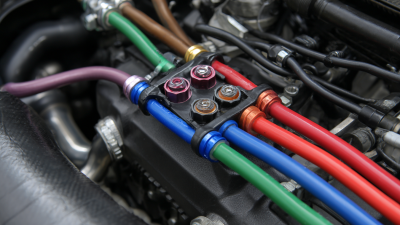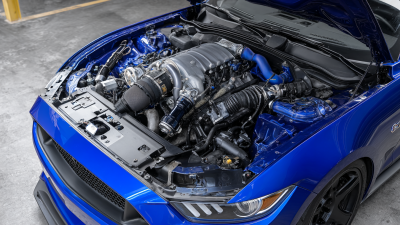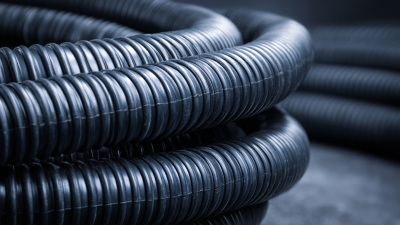 When it comes to enhancing your vehicle's performance, selecting the right components is crucial, and the choice of an Auto Silicone Hose can make a significant difference. According to a recent report from the Automotive Industry Association, approximately 30% of vehicle performance issues can be traced back to improper hose selection, which affects fluid flow, temperature management, and overall engine efficiency.
Auto Silicone Hoses are designed to withstand extreme temperatures and pressures, making them ideal for high-performance applications. They not only improve the durability of your vehicle's cooling and vacuum systems but also increase resistance to damage from oil and chemicals.
Understanding the specific needs of your vehicle's system is paramount, and this guide will provide you with the insights necessary to make an informed decision.
When it comes to enhancing your vehicle's performance, selecting the right components is crucial, and the choice of an Auto Silicone Hose can make a significant difference. According to a recent report from the Automotive Industry Association, approximately 30% of vehicle performance issues can be traced back to improper hose selection, which affects fluid flow, temperature management, and overall engine efficiency.
Auto Silicone Hoses are designed to withstand extreme temperatures and pressures, making them ideal for high-performance applications. They not only improve the durability of your vehicle's cooling and vacuum systems but also increase resistance to damage from oil and chemicals.
Understanding the specific needs of your vehicle's system is paramount, and this guide will provide you with the insights necessary to make an informed decision.
Silicone hoses play a crucial role in enhancing vehicle performance by improving fluid transport efficiency and heat resistance. According to a report by the Specialty Equipment Market Association (SEMA), replacing traditional rubber hoses with high-quality silicone alternatives can lead to performance gains, especially in high-temperature and high-pressure applications. These hoses can withstand extreme temperatures ranging from -40°F to 500°F, ensuring optimal flow of coolant, air, and other fluids critical to engine operation.
Moreover, the versatility of silicone hoses is supported by a study published in the Journal of Automotive Engineering, which highlights their superior durability and flexibility compared to conventional materials. This adaptability not only decreases the risk of leakage but also extends the service life of the hoses, translating to reduced maintenance costs. For performance enthusiasts looking to enhance their vehicle's capabilities, understanding the importance of high-grade silicone hoses is essential in meeting specific performance needs while ensuring reliability under demanding conditions.
| Hose Type | Temperature Range (°C) | Pressure Rating (psi) | Application | Advantages |
|---|---|---|---|---|
| Straight Silicone Hose | -60 to 200 | 50 | Intake, Coolant | Flexibility, High Temperature Resistance |
| Elbow Silicone Hose | -60 to 220 | 40 | Turbo, Radiator | Space-Saving, High Flow |
| Reducer Silicone Hose | -50 to 180 | 60 | Intercooler, Exhaust | Adaptability, Smooth Transitions |
| Bellow Silicone Hose | -60 to 180 | 30 | Vacuum, Vibration | Shock Absorption, Compact Design |
| High-Temp Silicone Hose | -60 to 300 | 80 | High-Performance Engines | Extreme Heat Resistance, Durability |
 When selecting silicone hoses for your vehicle's performance needs, there are several key factors to consider. Firstly, the temperature and pressure ratings of the hoses are crucial. Silicone hoses can withstand extreme heat, making them ideal for high-performance applications. This is especially important in the automotive sector, where engine performance can be heavily impacted by heat management. A recent report forecasts the industrial rubber market will reach $14.90 billion by 2030, highlighting the growing demand for quality automotive components, including silicone hoses.
When selecting silicone hoses for your vehicle's performance needs, there are several key factors to consider. Firstly, the temperature and pressure ratings of the hoses are crucial. Silicone hoses can withstand extreme heat, making them ideal for high-performance applications. This is especially important in the automotive sector, where engine performance can be heavily impacted by heat management. A recent report forecasts the industrial rubber market will reach $14.90 billion by 2030, highlighting the growing demand for quality automotive components, including silicone hoses.
Another factor to take into account is the compatibility of the silicone material with various fluids. Different vehicles require hoses that not only fit correctly but also resist degradation from oil, coolant, and other automotive fluids. The evolution of battery thermal management systems for electric vehicles has underscored the importance of high-performance components in modern vehicles. Understanding the specific requirements for your vehicle—whether it's a traditional combustion engine or an electric vehicle—will help ensure optimal performance and longevity of silicone hoses.
When it comes to selecting the right silicone hose for your vehicle, understanding the different types available is crucial for optimizing performance. Silicone hoses are popular in automotive applications due to their flexibility, resistance to temperature extremes, and ability to handle various fluids. The most common types include straight hoses, elbows, and reducers. Each one serves a specific purpose, allowing for customized air and coolant flow routes in your engine setup.

Choosing the right type depends largely on your specific performance requirements. If you're looking for a direct airflow path, straight hoses are ideal. For redirecting airflow or coolant at angles, elbows come in multiple degrees to fit your needs. Reducers are perfect for connecting components of differing diameters, ensuring a tight, efficient seal. Assessing your vehicle's layout and the intended performance modifications will guide you towards the most suitable silicone hose, enhancing both the efficiency and reliability of your automotive system.
When it comes to optimizing your vehicle's performance, high-quality silicone hoses play a crucial role. Unlike traditional rubber hoses, silicone hoses can withstand higher temperatures and pressures, making them ideal for demanding automotive applications. Their flexibility and durability ensure that they maintain performance even under extreme conditions, providing a reliable connection between the engine and various components. By upgrading to silicone hoses, you can enhance airflow, improve cooling efficiency, and ultimately increase the overall performance of your vehicle.
Choosing the right silicone hose involves considering several factors, such as diameter, length, and bend radius. It’s essential to select hoses that fit your specific make and model to avoid leaks and performance issues. Opting for reinforced silicone hoses can further enhance durability, preventing collapsing under high vacuum conditions. Additionally, many silicone hoses come in various colors and finishes, allowing you to personalize your vehicle's engine bay aesthetics while benefiting from enhanced functionality. Investing in high-quality silicone hoses is a practical step towards achieving top-tier performance in your vehicle.
When it comes to maintaining the performance of your vehicle, auto silicone hoses play a crucial role. These hoses are designed to withstand high temperatures and pressures, but regular maintenance is essential for longevity. Here are some tips to help extend the life of your silicone hoses.
Firstly, regularly inspect your silicone hoses for any signs of wear or damage. Look for cracks, splits, or fading, which can indicate that the hose is nearing the end of its lifespan. Keeping an eye out for these issues allows you to replace hoses before they fail, ensuring your vehicle maintains optimal performance.
Secondly, ensure proper installation and alignment during replacement. Misaligned hoses can cause excessive stress, leading to premature deterioration. Use quality clamps to secure hoses tightly without overtightening, which can deform them. Additionally, avoid exposure to harsh chemicals and UV light whenever possible, as these can degrade the silicone material over time.
Lastly, consider applying a silicone protectant to your hoses. This can help shield them from environmental factors and maintain their elasticity. Incorporating these maintenance tips can significantly enhance the durability of your auto silicone hoses, contributing to better overall vehicle performance.






